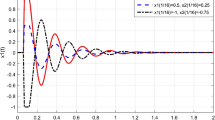Abstract
In this paper, a class of third-order quasi-linear differential equations withcontinuously distributed delay is studied. Applying the generalized Riccatitransformation, integral averaging technique of Philos type and Young’sinequality, a set of new criteria for oscillation or certain asymptoticbehavior of nonoscillatory solutions of this equations is given. Our resultsessentially improve and complement some earlier publications.
Similar content being viewed by others
1 Introduction
Consider the following third-order quasi-linear differential equation:
We build up the following hypotheses firstly:
(H1) and ;
(H2) and ;
(H3) is not a decreasing function for μ andsuch that
(H4) ;
(H5) is not a decreasing function for ξ andsuch that
(H6) and ;
(H7) γ is a quotient of odd positive integers.
Define the function by
A function is a solution of (1) means that, , and satisfies (1) on . In this paper, we restrict our attention to thosesolutions of Eq. (1) which satisfy for all . We assume that Eq. (1) possesses such asolution. A solution of Eq. (1) is called oscillatory on if it is eventually positive or eventually negative;otherwise, it is called nonoscillatory.
In recent years, there has been much research activity concerning the oscillationtheory and applications of differential equations; see [1–4] and the reference contained therein. Especially, the study content ofoscillatory criteria of second-order differential equations is very rich. Incontrast, the study of oscillatory criteria of third-order differential equations isrelatively less, but most of works are about delay equations. Some interestingresults have been obtained concerning the asymptotic behavior of solutions of Eq.(1) in the particular case. For example, [5] consider the third-order functional differential equations of the form
Zhang et al.[6] focus on the following the third-order neutral differential equationswith continuously distributed delay:
Baculíková and Džurina [7] are concerned with the couple of the third-order neutral differentialequations of the form
However, as we know, oscillatory behaviors of solutions of Eq. (1) have not beenconsidered up to now. In this paper, we try to discuss the problem of oscillatorycriteria of Philos type of Eq. (1). Applying the generalized Riccati transformation,integral averaging technique of Philos type, Young’s inequality,etc., we obtain some new criteria for oscillation or certain asymptoticbehavior of nonoscillatory solutions of this equations. We should point out thatγ is any quotient of odd positive integers in this paper, but itis required that in [6].
2 Several lemmas
We start our work with the classification of possible nonoscillatory solutions of Eq.(1).
Lemma 2.1 Letbe a positive solution of (1), andis defined as in (4). Thenhas only one of the following two properties eventually:
-
(I)
, , ;
-
(II)
, , .
Proof Let be a positive solution of (1), eventually (if it iseventually negative, the proof is similar). Then . Thus, is decreasing and of one sign and it followshypotheses (H2)-(H7) that there exists such that is of fixed sign for . If we admit , then there exists a constant such that
Integrating from to t, we get
Let and using (H1), we have . Thus eventually, which together with implies , which contradicts our assumption. This contradiction shows that, eventually. Therefore is increasing and thus (I) or (II) holds for, eventually. □
Lemma 2.2 Letbe a positive solution of (1), and correspondinglyhas the property (II). Assume that
Then
Proof Let be a positive solution of Eq. (1). Since satisfies the property (II), it is obvious that thereexists a finite limit
Next, we claim that . Assume that , then we have for all and t enough large. Choosing, we obtain
where . □
Combining (H6), (13) with (1), one can get
where and . Integrating inequality (14) from t to∞, we get immediately
Using , we have
We have a contradiction with (10) and so it follows that , which implies that
Lemma 2.3[7]
Assume that, , on. Then, for each, there existssuch that
Lemma 2.4[8]
Let, , , on. Then there existandsuch that
3 Main results
For simplicity, we introduce the following notations:
A function is said to belong to X class if it satisfies
-
(i)
, ; , ;
-
(ii)
, there exist and such that
(21)
Theorem 3.1 Assume that (10) holds, there existandsuch that
Suppose, further, that. Then every solutionof Eq. (1) is either oscillatory or converges to zero.
Proof Assume that Eq. (1) has a nonoscillatory solution. Without loss of generality, we may assume that, , , , , , is defined as in (4). By Lemma 2.1, we have that has the property (I) or the property (II). If has the property (II). Since (10) holds, then theconditions in Lemma 2.2 are satisfied. Hence .
When has the property (I), we obtain
Using (H5) and (H6), we have
where and . Let
Then
Choosing in Lemma 2.2, we obtain
Using Lemma 2.3, we get
Combining with (27)-(29), we have
where is defined by (23). Let
For , we have
where . By Young’s inequality
we obtain
Applying (33) to inequality (31), we obtain
Therefore, we have
The last inequality contradicts (22). □
Theorem 3.2 Assume that other conditions of Theorem 3.1 are satisfied exceptcondition (22). Further, for every T, the following inequalities hold:
and
If there exists such that
where, then every solutionof Eq. (1) is either oscillatory or converges to zero.
Proof As the proof of Theorem 3.1, we can see that (31) holds. It followsthat
where .
By (45), we get
and hence
Define the functions and as follows:
From (37) and (42), we obtain
The remainder of the proof is similar to the theorem given in [9–11] and hence is omitted. If has the property (II), since (10) holds, by Lemma2.2, we have . □
Theorem 3.3 If we replace (37) by
and assume that the other assumptions of Theorem 3.2 hold,then every solution of Eq. (1) is either oscillatory or convergesto zero.
Proof The proof is similar to Theorem 3.2 and hence isomitted. □
Remark 3.4 When , Theorems 3.1-3.3 with condition (37) reduce toTheorems 3.1-3.3 of Zhang [6], respectively.
References
Agarwal RP, Grace SR, O’Regan D: Oscillation Theory for Difference and Functional DifferentialEquations. Kluwer Academic, Dordrecht; 2000.
Agarwal RP, Grace SR, O’Regan D: Oscillation Theory for Second Order Dynamic Equations. Taylor & Francis, London; 2003.
Erbe LH, Kong Q, Zhang BG: Oscillation Theory for Functional Differential Equations. Dekker, New York; 1995.
Philos CG: Oscillation theorems for linear differential equations of second order. Arch. Math. 1989, 53: 482-492. 10.1007/BF01324723
Baculíková B, Džurina J: Oscillation theorems for higher order neutral differential equations. Appl. Math. Comput. 2012, 219: 3769-3778. 10.1016/j.amc.2012.10.006
Zhang Q, Gao L, Yu Y: Oscillation criteria for third-order neutral differential equations withcontinuously distributed delay. Appl. Math. Lett. 2010, 25: 1514-1519.
Baculíková B, Džurina J: Oscillation of third-order neutral differential equations. Math. Comput. Model. 2010, 52: 215-226. 10.1016/j.mcm.2010.02.011
Kiguradze IT:On the oscillation of solutions of the equations . Sb. Math. 1964, 65(2):172-187.
Rogovchenko YV: Oscillation theorems for second-order equations with damping. Nonlinear Anal. 2000, 41: 1005-1028. 10.1016/S0362-546X(98)00324-1
Tiryaki A, Yaman S: Asymptotic behavior of a class of nonlinear functional differential equationsof third order. Appl. Math. Lett. 2001, 14: 327-332. 10.1016/S0893-9659(00)00157-9
Tiryaki A, Aktas MF: Oscillation criteria of a certain class of third order nonlinear delaydifferential equations with damping. J. Math. Anal. Appl. 2007, 325: 54-68. 10.1016/j.jmaa.2006.01.001
Acknowledgements
The authors would like to thank Prof. Yuanhong Yu and the anonymous reviewer fortheir constructive and valuable comments, which have contributed much to theimproved presentation of this paper. This work was supported by the NationalScience and Technology Major Projects of China (Grant No. 2012ZX10001001-006),the National Natural Science Foundation of China (Grant No. 11101053, 7117102471371195), the Scientific Research Fund of Hunan Provincial Education Departmentof China (Grant No. 11A008) and the Planned Science and Technology Project ofHunan Province of China (Grant No. 2012SK3098, 2013SK3143).
Author information
Authors and Affiliations
Corresponding author
Additional information
Competing interests
The authors declare that they have no competing interests.
Authors’ contributions
The work presented here was carried out in collaboration between all authors. GQcarried out the design of the study and drafted the manuscript. CH and YX conceived,instructed the design of the study and polished the manuscript. FW participated indiscussion and completed the revision of the manuscript. All authors read andapproved the final manuscript.
Rights and permissions
Open Access This article is distributed under the terms of the Creative Commons Attribution 2.0 International License ( https://creativecommons.org/licenses/by/2.0 ), which permits unrestricted use, distribution, and reproduction in any medium, provided the original work is properly cited.
About this article
Cite this article
Qin, G., Huang, C., Xie, Y. et al. Asymptotic behavior for third-order quasi-linear differential equations. Adv Differ Equ 2013, 305 (2013). https://doi.org/10.1186/1687-1847-2013-305
Received:
Accepted:
Published:
DOI: https://doi.org/10.1186/1687-1847-2013-305




